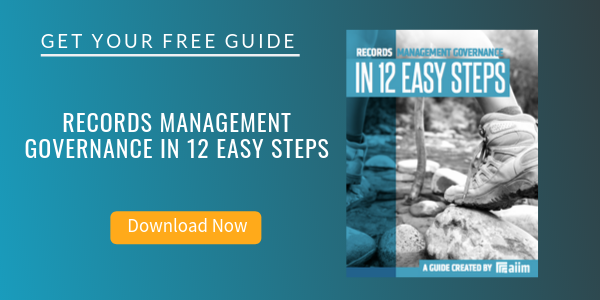
8 Things to Help Contain the Cost & Risk of Litigation
Information Governance | Compliance | Information Security
-
Get your (information) house in order.
It's no secret that companies of all sizes in all industries are creating and storing more documents, in more formats than ever before, driven partly by regulatory and compliance pressures. Gaining control of your information is sound business practice. And knowing what you have (physical and digital) and where is it can be found is critical when litigation occurs.
-
Know how long to keep it.
Every official record has a lifespan, some longer than others. Developing and implementing a sensible and legally credible retention schedule (how long you need to store that record) helps reduce data volumes (you can dispose of information not required to meet legal, regulatory, business or compliance obligations) while ensuring you can produce information when you need it. Oftentimes, there are industry- or federally-mandated guidelines for these schedules; in some cases, it’s just “good business’ to retain these records. If you don’t know the schedule or need help developing one, seek out external experts and consultants for guidance.
-
Reduce legal fees by bringing some of the processes in house.
General Counsels and corporate legal teams have to find creative ways to help contain legal costs. Functions that were often performed in the past by outside counsel, such as the conversion of physical records to digital for review, can often be more efficiently and cost-effectively handled by an information management service partner. These providers can achieve greater cost savings and national coverage for consistency vs. working with more regional, niche vendors. If the provider already stores your physical records, the improved chain of custody reduces risk while saving on transportation and delivery costs.
-
Look for a complete solution from a single vendor.
Choosing an integrated solution will improve regulatory compliance, reduce the complexity of the discovery process, increase response time, and help mitigate the high cost of litigation. A comprehensive program gives you greater accountability in addressing all phases of the litigation process with greater speed and accuracy. Plus, you get the assurance that your solution provider can scale up or down to your needs.
-
Have a defensible data gathering plan.
In most cases, parties in litigation have 99 days or less to confer about what data must be preserved and to produce it. When litigation requests arrive, organizations need to create a plan for finding and collecting information that can be implemented quickly and is defensible. To be successful, General Counsel, IT, and Records Management all need to play in the development and implementation of such a plan. By leveraging records management software, you will be able to classify information for streamlined access, consistently manage retention to reduce the amount of data that needs to be searched and apply holds to ensure preservation. Reducing the volume of information required for review saves on legal fees, which can easily be $100 per hour or more.
-
Identify your high-risk information, and scan in advance.
Many organizations have begun digitizing their physical records to streamline their storage and access processes. The benefits of this approach are better management, greater levels of compliance, and less risk, not to mention quicker access to your information. But one of the biggest benefits is the ability to identify high-risk documents, which can then be pre-loaded into an eDiscovery platform before litigation, enabling greater processing and review efficiencies as well as cost savings.
-
Ensure Secure Chain of Custody.
Records and information involved in discovery may be critical to the outcome of your case. Understanding the sensitive nature of information, you must establish a full chain of custody, so you know where that information is at all times. If you choose a partner to manage your information, they should be able to provide the same levels of security and peace of mind, Failure to do so can be extremely costly in dollars and potential damage to your reputation.
-
Don’t just apply technology.
There are many tools and technologies which promise to deliver a complete solution for litigation support, but technology alone is not the answer. You can extend your technology and process investments by adding in expertise and best practices from a trusted partner for your litigation readiness plan. A true solution partner will give you capabilities (such as conversion services) and valuable consulting to help solve complex litigation challenges.
About John Mancini
John Mancini is the President of Content Results, LLC and the Past President of AIIM. He is a well-known author, speaker, and advisor on information management, digital transformation and intelligent automation. John is a frequent keynote speaker and author of more than 30 eBooks on a variety of topics. He can be found on Twitter, LinkedIn and Facebook as jmancini77. Recent keynote topics include: The Stairway to Digital Transformation Navigating Disruptive Waters — 4 Things You Need to Know to Build Your Digital Transformation Strategy Getting Ahead of the Digital Transformation Curve Viewing Information Management Through a New Lens Digital Disruption: 6 Strategies to Avoid Being “Blockbustered” Specialties: Keynote speaker and writer on AI, RPA, intelligent Information Management, Intelligent Automation and Digital Transformation. Consensus-building with Boards to create strategic focus, action, and accountability. Extensive public speaking and public relations work Conversant and experienced in major technology issues and trends. Expert on inbound and content marketing, particularly in an association environment and on the Hubspot platform. John is a Phi Beta Kappa graduate of the College of William and Mary, and holds an M.A. in Public Policy from the Woodrow Wilson School at Princeton University.



